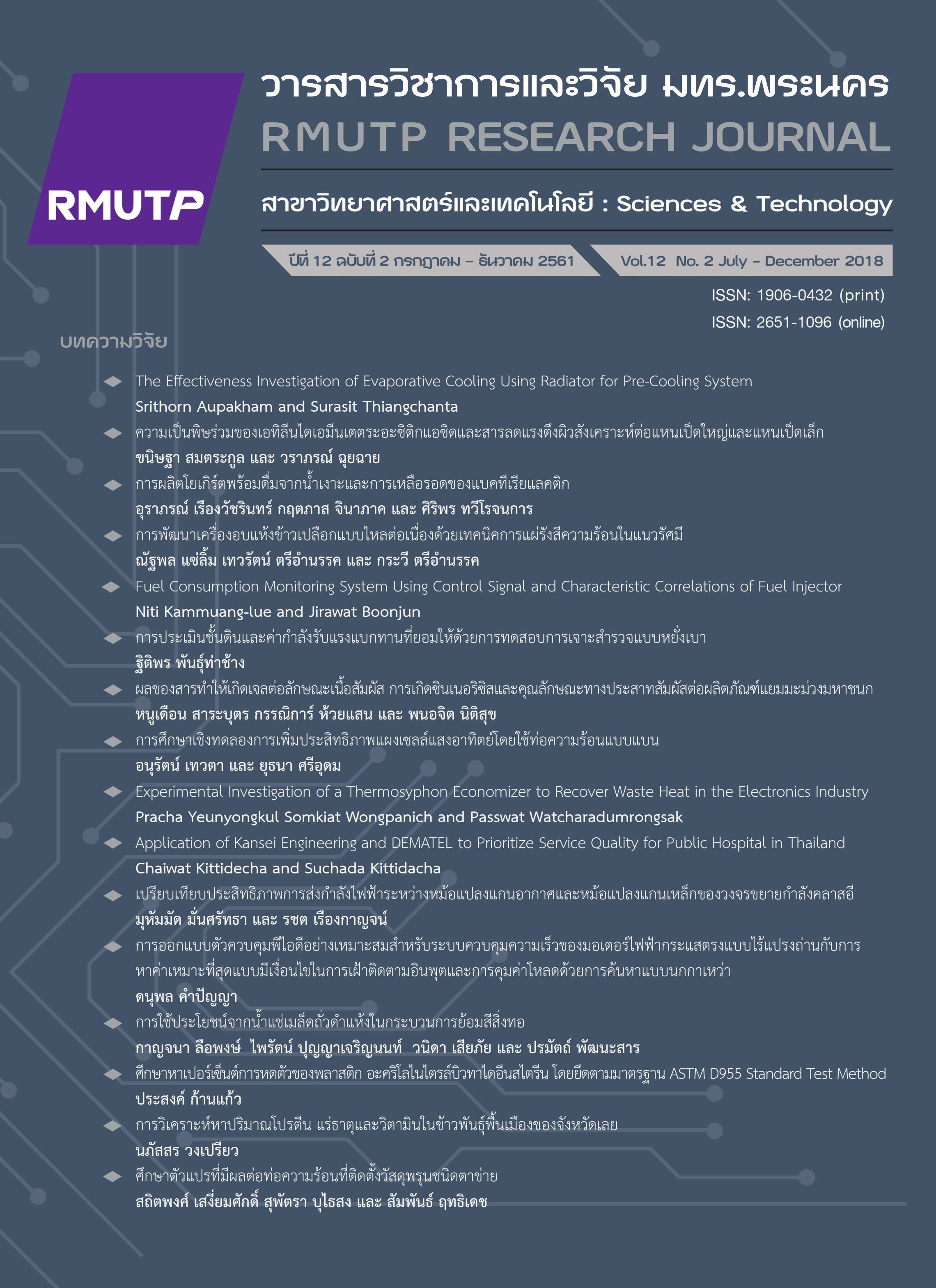การวิเคราะห์หาปริมาณโปรตีน แร่ธาตุและวิตามินในข้าวพันธุ์พื้นเมืองของจังหวัดเลย
Main Article Content
บทคัดย่อ
งานวิจัยนี้มีวัตถุประสงค์เพื่อศึกษาปริมาณโปรตีน แร่ธาตุและวิตามินในข้าวพันธุ์พื้นเมือง จำนวน 19 สายพันธุ์ 36 ตัวอย่าง จากจังหวัดเลย ผลการศึกษาพบว่าข้าว 36 ตัวอย่างมีปริมาณโปรตีนในช่วง 7.16±0.15-11.05±0.12 กรัมต่อ 100 กรัม ข้าวเหนียวดำลืมผัว (LR22) มีปริมาณฟอสฟอรัสสูงสุดมีค่าเท่ากับ 263.85±0.19 มิลลิกรัมกรัมต่อ 100 กรัม การวิเคราะห์หาธาตุเหล็กและแคลเซียมด้วยเทคนิคเฟลมอะตอมมิกแอบซอร์พชันสเปคโทรโฟโตเมทรี พบปริมาณความเข้มข้นของธาตุเหล็กมากที่สุดในข้าวหอมทุ่ง (LR7) มีค่าอยู่ที่ 7.31±0.14 มิลลิกรัมต่อ 100 กรัม และพบแคลเซียมสูงสุดในข้าวเหนียวดำลืมผัว (LR22) มีค่าเท่ากับ 11.15±0.24 มิลลิกรัมกรัมต่อ 100 กรัม ในการวิเคราะห์หาวิตามินทั้ง 3 ชนิด ด้วยเทคนิคโครมาโทกราฟีของเหลวสมรรถนะสูง พบว่าข้าวสัมบาย (LR14) มีปริมาณบีตาแคโรทีนสูงสุดมีค่าเท่ากับ 0.08±0.14 มิลลิกรัมต่อกิโลกรัม ในขณะที่ไม่พบบีตาแคโรทีนในข้าวพันธุ์พื้นเมือง 15 ตัวอย่าง ได้แก่ ข้าวปลาซิวน้อย (LR3) ข้าวหอมเสงี่ยม (LR6) ข้าวหอมทุ่ง (LR7) ข้าวสันป่าตอง (LR12) ข้าวสันป่าตองดอ (LR13) ข้าวโซเวียด(LR15) ข้าวสันติบาล(LR16) ข้าวหล่มปี(LR17) ข้าวเล้าแตก (LR19) ข้าวปลาซิวน้อย (LR20) ข้าวหอมเสงี่ยม (LR27) ข้าวหอมทุ่ง (LR28) ข้าวแพร่ (LR30) ข้าวแม้ว (LR31) ข้าวแดง (LR32) และข้าวปลาซิวน้อย (LR35) ปริมาณแอลฟาโทโคฟีรอลและไธอะมีนพบสูงสุดในข้าวเหนียวดำลืมผัว (LR36) มีค่าอยู่ที่ 16.18±0.09 และ 12.08±0.18 มิลลิกรัมต่อกิโลกรัม ตามลำดับ ข้อมูลที่ได้จากการวิจัยครั้งนี้ถือเป็นข้อมูลพื้นฐานในการเลือกบริโภค ส่งเสริมการเพาะปลูกและอนุรักษ์ข้าวพันธุ์พื้นเมือง รวมทั้งสามารถนำไปพัฒนาต่อยอดเป็นผลิตภัณฑ์ต่าง ๆ ในอนาคตได้
Article Details
เอกสารอ้างอิง
[2] P. Rujirapisit. et al., “Nutritional Value of 9 Rice Cultivars” Agricultural Science Journal, vol. 43, no. 2, pp. 173-176, 2012.
[3] Horwitz W, Official Method of Analysis of AOAC International, 17th ed, AOAC International, Maryland, USA. 2000.
[4] AOAC, Official Method of Analysis of AOAC International. 17th ed. AOAC International
Inc., Gaithersberg, MD. USA .Official Method 958.01, 2000.
[5] AOAC, Determination of Lead, Cadmium, Copper, Iron and Zinc in food Atomic Absorption Spectrophotometry after dry ashing, 17th ed, Official methods, 999.11, 2000.
[6] A.J. Speek, et al., “Determination of beta- carotene content and vitamin A activety of vegetables by high-performance liquid chromatography and spectrophotometry,” Food chem, vol. 19 pp. 65-74, 1985.
[7] F. Sancho, et al., “Effect of ultra-hight hydrostatic pressure on hydrosoluble vitamins,” Journal of Food Engineering, vol. 39, pp. 247-253,1998.
[8] C. Chaowaneeporn, et al., “Chemical Composition and Amylose Content in Local Rice Variety of Phatthalung Province,” M.S. thesis, Chemistry program, Faculty of Science and Technologry, Songkhla Rajabhat Univ., Songkhla., Thailand, 2015.
[9] Y. Huang, et al., “Variation in mineral elements in grains of 20 brown rice accessions in two environments,” Food Chemistry, vol. 192, pp. 873 - 878. 2015.
[10] M. Amparo Asensi-Fabado and Sergi Munne´-Bosch, “Vitamins in plants: occurrence, biosynthesis and antioxidant function,” Trends in Plant Science, vol.15 No.10, pp.582-592. 2010.


